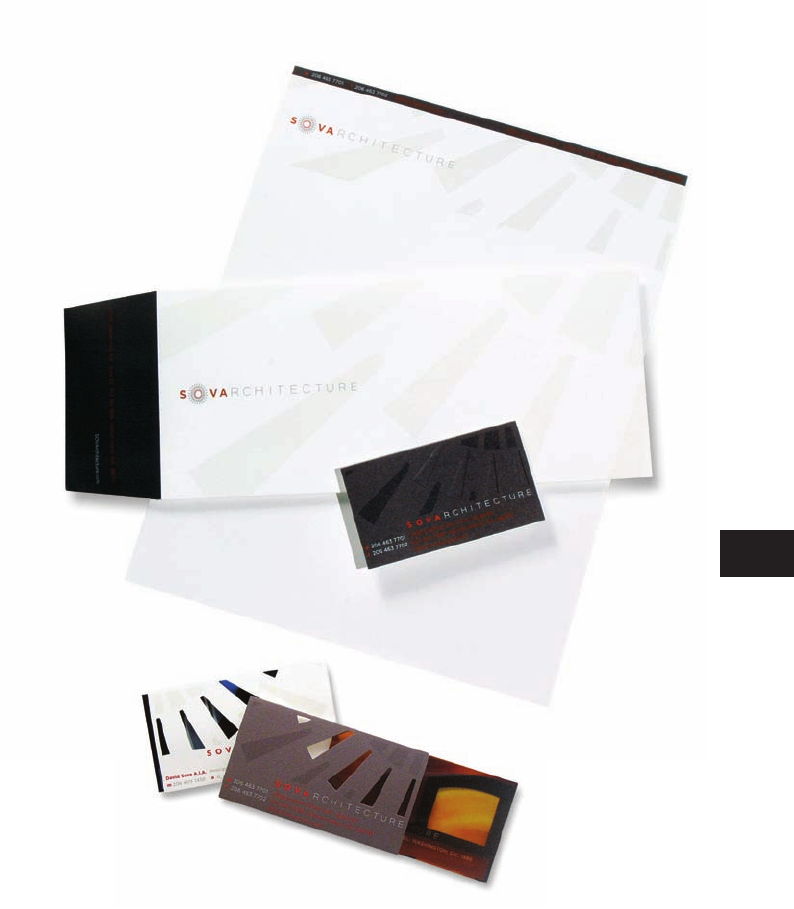
The Complete Graphic Designer
130
Paper Systems
All of an organization’s printed
collateral for correspondence
with employees and customers
comprise the overall paper system,
which is often referred to as the
stationery system. At the bare mini-
mum, this generally includes let-
terhead, secondary sheets (in case
any correspondence is more than
one page in length), business cards,
and envelopes. In many cases, and
depending upon the client’s needs,
mailing labels for packages, fax
cover sheets, CD labels, note cards,
and forms such as invoices are also
required. When developing a paper
system solution, the goal is to cre-
ate a system that works on two
levels—as individual pieces and as
part of a cohesive whole.
Components of an
Identity Program
The profile of a woman is used as a strik-
ing graphic on this stationery for a fashion
consultant. Deconstructing the logo and using
the logotype and mark as separate elements
allows for more design possibilities.
Design: Brainding
A very technical look was desired for Blackstone
Technology Group’s paper system, so a modular,
grid- and graph-like structure was incorporated
into the various elements of the system, includ-
ing the fi rm’s business cards.
Design: Templin Brink
Letterhead
The company’s or organization’s
logo should be prominently fea-
tured along with the company’s
legal name (including any suffi x
such as Inc., Pty., Ltd., etc.), address,
and phone number. Although many
company stationery systems have
the logo placed in the upper left
corner of the paper, it does not
necessarily have to live at the top
of the page. In some cases, it might
make sense for the logo to appear
on the side or at the bottom of the
letterhead, which is becoming more
and more common. However, logo
and contact information should not
be placed too close to the edge of
the sheet because they risk being
trimmed off when printed. It is also
advisable to allow as much space as
possible for the content of a letter,
TB
Provision-Complete Graphic Designer
CD109-59/4028
1st
proof
CGD p112-143_Text file_.indd 130CGD p112-143_Text file_.indd 130 1/20/09 12:31:36 PM1/20/09 12:31:36 PM

131
Corporate Identity
since most companies like to limit
correspondence to one page.
Envelopes
Most envelopes for corporate
identities use standard sizes, such
as #10 (9 1/2” x 4 1/8”) or A4 (210
x 297mm). However, some compa-
nies may have a need for, or simply
choose to use, an alternative size.
Regardless, the return address for
the company or organization should
appear on the face or the fl ap of
the envelope. The envelope usually
gets thrown away after a letter is
opened, so including a phone num-
ber or website on the envelope is
unnecessary. Keeping those specifi c
details out of the public eye is best,
especially given the increase in
spam, telemarketers, and junk mail.
Additionally, no artwork should ap-
pear on the bottom 5/8”(1.0 cm) of
the envelope due to postal regula-
tions in the United States.
For SOVArchitects, a clean system using black
and red has been established to represent the
company. Graphic elements reminiscent of light
passing through an opening have been added to
give the identity a more dynamic feel. This paper
system also utilizes a policy-style envelope in
which the opening is on the end of the envelope
as opposed to the top.
Design: Hornall Anderson Design Works
TB
Provision-Complete Graphic Designer
CD109-59/4028
1st
proof
CGD p112-143_Text file_.indd 131CGD p112-143_Text file_.indd 131 1/20/09 12:31:38 PM1/20/09 12:31:38 PM
Get The Complete Graphic Designer now with the O’Reilly learning platform.
O’Reilly members experience books, live events, courses curated by job role, and more from O’Reilly and nearly 200 top publishers.

